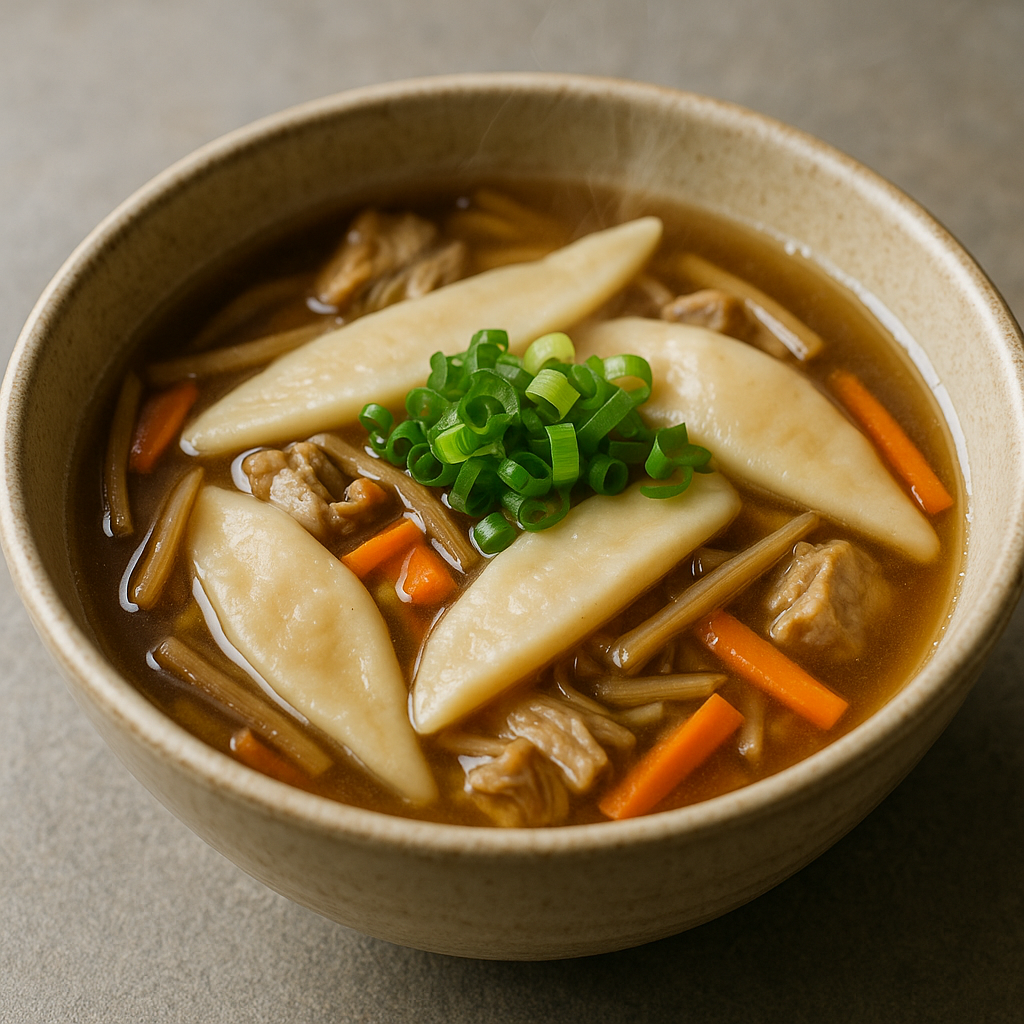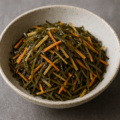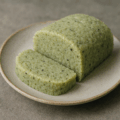柳ばっとの特徴
柳の葉のかたちに切った“そば生地”の汁もの
「柳ばっと」は、そば粉(場合により小麦粉を少量合わせる)を熱湯でこねて薄くのばし、柳の葉のような形に切って、野菜たっぷりの汁に落として煮る岩手県北部の郷土料理です。具だくさんの汁にそば生地を加えた、主食にもなる一椀として親しまれてきました。
根菜・きのこの旨みを受け止める素朴なコク
だしで煮たごぼう、にんじん、きのこ、ねぎなどの風味を、生地がやさしくまとい、食べ進むほどに旨みが広がります。寒い季節の栄養源としても重宝されました。
柳ばっとのレシピ
材料(4人分)
- そば粉 … 150g
- 薄力粉 … 50g(つなぎ・省略可)
- 塩 … 小さじ1/3
- 熱湯 … 130〜160ml(様子を見て)
- ごぼう … 1/2本(ささがき)
- にんじん … 1/2本(半月切り)
- だし … 1,000ml(昆布+かつお など)
- 酒 … 大さじ1
- みりん … 大さじ1
- 醤油 … 大さじ2〜3
- 塩 … 少々
作り方
- 生地づくり:そば粉・薄力粉・塩を混ぜ、熱湯を少しずつ加えて箸でまとめ、手で<耳たぶ程度>にこねる。ラップで包み30分休ませる。
- のばす・切る:生地を2〜3mm厚にのばし、楕円〜葉形に切る(長さ5〜7cm目安)。乾かないようぬれ布巾をかける。
- 汁を煮る:鍋にだしを沸かし、酒・みりんを加える。ごぼう・にんじんを入れ中火で7〜8分煮る。
- 柳ばっとを落とす:弱めの沸騰を保ち、生地を数回に分けて静かに投入。生地が半透明になり、醤油で調味し1〜2分。塩で味を整える。
- 仕上げ:火を止めて1〜2分休ませ、椀に盛る。
シェフのワンポイントアドバイス
- 生地は湯練り+休ませで伸びやすく。薄く不揃いにのばすと食感に抑揚が出ます。
- 投入は少量ずつ。強い沸騰は避け、静かな煮立ちで煮崩れ防止。
- つなぎ粉(薄力粉)を入れると成形しやすく初心者向け、香り重視ならそば粉多めに。
- 現代風にするならば鶏肉か豚肉を入れた方が美味しいですね。
栄養価(1杯の目安)
- エネルギー:約320〜430 kcal
- たんぱく質:10〜16 g
- 脂質:4〜10 g
- 炭水化物:55〜70 g
そば+野菜中心で比較的低脂質。塩分は醤油量で調整しやすいです。
歴史
冬の栄養源として広がった“主食になる汁物”
岩手県北部で、野菜やきのこがたっぷり入った汁に柳の葉形のそばを加える料理として定着。寒い季節に体を温め、栄養を補う日常の一椀として受け継がれてきました。
はっと・ひっつみと同系の粉もの文化
東北〜北関東に広がる“ちぎり麺・平打ち団子”の系譜と近く、そば粉を葉形にのばす点が柳ばっとの個性です。
English Version
Features of “Yanagi Batto”
Soba dough cut like willow leaves, simmered in broth
“Yanagi Batto” is a local soup from northern Iwate. Soba flour (sometimes blended with a little wheat flour) is scalded with boiling water, rolled thin, and cut into willow-leaf shapes, then slipped into a vegetable broth to simmer. It’s a hearty bowl that can stand in for a main course.
Rustic dough that absorbs the flavor of root vegetables
The broth—cooked with burdock and carrot—clings gently to the thin pieces of dough, growing more flavorful with each bite. It’s a warming, everyday dish for the cold season. (Mushrooms and scallions are common add-ins.)
Recipe
Ingredients (Serves 4)
- Soba flour … 150 g
- All-purpose flour … 50 g (optional binder)
- Salt … 1/3 tsp
- Boiling water … 130–160 ml (as needed)
- Burdock root … 1/2 pc (shaved into sasagaki)
- Carrot … 1/2 pc (half-moon slices)
- Dashi … 1,000 ml (kombu & katsuobushi)
- Sake … 1 Tbsp
- Mirin … 1 Tbsp
- Soy sauce … 2–3 Tbsp
- Salt … a pinch
Instructions
- Make the dough: Mix soba flour, all-purpose flour, and salt. Add boiling water little by little, bring together with chopsticks, then knead by hand until soft and pliable (earlobe texture). Wrap and rest 30 minutes.
- Roll & cut: Roll the dough 2–3 mm thick. Cut into oval, leaf-like pieces 5–7 cm long. Keep covered with a damp cloth so they don’t dry out.
- Simmer the broth: Bring dashi to a boil, add sake and mirin. Add burdock and carrot; simmer over medium heat 7–8 minutes.
- Cook the “leaves”: Keep the broth at a gentle simmer. Add the dough pieces in batches. When they turn slightly translucent, season with soy sauce and simmer 1–2 minutes. Adjust with a pinch of salt.
- Finish: Turn off the heat, let stand 1–2 minutes, and ladle into bowls.
Chef’s Tips
- Scalding the dough with boiling water and resting it makes it easier to roll thin. A little irregularity in thickness gives a pleasant, rustic texture.
- Add the pieces in small batches and avoid a rolling boil to prevent breaking.
- Using some all-purpose flour helps beginners handle the dough; use more soba flour if you prefer stronger buckwheat aroma.
- Modern variation: add a little chicken or pork for extra richness.
Nutritional Value (per bowl, approx.)
- Calories: 320–430 kcal
- Protein: 10–16 g
- Fat: 4–10 g
- Carbohydrates: 55–70 g
Relatively low in fat with soba and vegetables as the base. Adjust salt by tweaking the soy sauce.
History
A “meal in a bowl” that spread as a winter staple
In northern Iwate, thin leaf-shaped soba added to vegetable soup became a nourishing everyday dish that warms the body and replenishes energy in winter.
Part of the same flour-food lineage as “hatto” and “hittsumi”
It belongs to the regional family of torn or flat dumpling soups across Tohoku and northern Kanto, distinguished by its willow-leaf soba shape.



何でも質問してください!